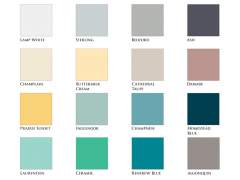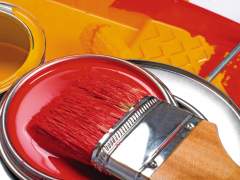Classifications of the paints used for finishing of the walls, ceilings, floors and facades of your houses and apartments.
Performing the paint finishes you should take into account that construction paints have a precisely defined formula, which determines their properties. Therefore, to apply the paint correctly and exactly as prescribed, you must know its structure and understand how its components will affect on the properties of the resulting coating. Here is the most common classifications of types of paints.
Paints are divided into:
Paints based on polymers are divided into:
- latex paints
- acrylic paints
- PVA based paints
Water-dispersive paints and water based paints
Water-dispersion and water-based paints are environmentally friendly and allow the surface to “breathe”. Polymer components make this type of paint more resistant to mechanical damage, moreover, they have fast drying time. Water-dispersion paints have high water resistance, while water-based paints can be washed off with water. Another difference between these types of paints is their color palette. Water-based paints have a wide range of colors, while water-dispersion paints are produces mostly of white color or of light shades. Both paints are often used for finishing works on the ceiling, because they are durable and do not change the color for a quite long period of time.
PVA based paints
 The main advantage of this type of paints is their low cost. They are very often used for finishing the ceilings in dry areas – they are afraid of moisture. Another disadvantage – their small palette of shades. Paints of this kind are not tintable on computer tinting machines – the pigment is added manually. Only light colors can be obtained with such type of tinting.
The main advantage of this type of paints is their low cost. They are very often used for finishing the ceilings in dry areas – they are afraid of moisture. Another disadvantage – their small palette of shades. Paints of this kind are not tintable on computer tinting machines – the pigment is added manually. Only light colors can be obtained with such type of tinting.
Acrylic paints
They are among the most popular types of wall paint nowadays. For high-quality finishing coating, acrylic latex paints are usually applied in two layers. The final coating is sufficiently flexible and are capable to cover cracks at the base of 1 mm wide. They have a good water resistance. These paints can be used in wet areas, but direct water contact should be avoided. Acrylic paints have a wide choice of colors for tinting, both light and dark shades.
Silicone paints
 These paints have binding agent in which silicone resins are emulsified. These paints are very elastic – they can cover the cracks at the base of 2 mm wide. The most important difference between silicone and acrylic paints is their resistance to alkalis. While, as mentioned above, acrylic paints can be applied to alkaline base not earlier than 30 days after, the silicone paints may be applied within 48 hours. Silicone coatings do not support the growth of microorganisms. Therefore, they do not require the use of special additives, both algicidal and fungicidal ones.
These paints have binding agent in which silicone resins are emulsified. These paints are very elastic – they can cover the cracks at the base of 2 mm wide. The most important difference between silicone and acrylic paints is their resistance to alkalis. While, as mentioned above, acrylic paints can be applied to alkaline base not earlier than 30 days after, the silicone paints may be applied within 48 hours. Silicone coatings do not support the growth of microorganisms. Therefore, they do not require the use of special additives, both algicidal and fungicidal ones.
Silicate paints
This paints are based on potash glass. Silicate paints are used exclusively for painting mineral surfaces, for example, mineral plasters, as well as surfaces previously coated with lime, cement or silicate paint. Silicate paints contain 5-10% alkali, so working with them requires certain precautions. Silicate paint corrodes glass and ceramics. If the paint splashes fall on the windows, floors, walls covered with tiles, you should immediately wash them off – each second counts! Coatings of silicate paints are not suitable when applied to plaster – otherwise, the cracks will appear. The used tools and equipment must be immediately cleaned with water. After curing cleaning is not possible.
Mineral paints
 They are of two types – cement and lime. Cements paint form a coating with a high vapor permeability and water resistance. They are most suitable for coloring concrete and masonry surfaces, which are exposed to moisture so strongly, that other paints and coatings can not withstand. Preferred area of application of lime paints – the old buildings plastered with lime or lime-cement plaster.
They are of two types – cement and lime. Cements paint form a coating with a high vapor permeability and water resistance. They are most suitable for coloring concrete and masonry surfaces, which are exposed to moisture so strongly, that other paints and coatings can not withstand. Preferred area of application of lime paints – the old buildings plastered with lime or lime-cement plaster.
Alkyd paints
Alkyd paints traditionally protect any types of surfaces from all sorts of wear and corrosion resistant, both outdoors and indoors (facades, doors, windows, furniture, radiators, etc.). They are used for the painting of wooden window frames, doors, walls, floors, ceilings in kitchens and bathrooms. They have super high water resistance.
We hope now you know much more on the paints type and feel free to start making your own choice.




